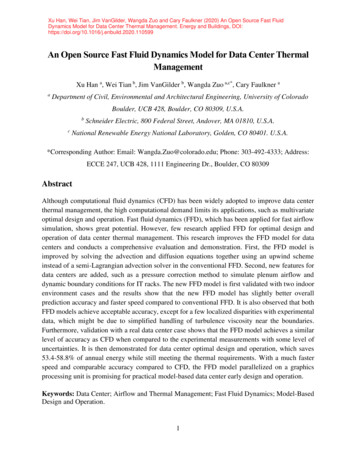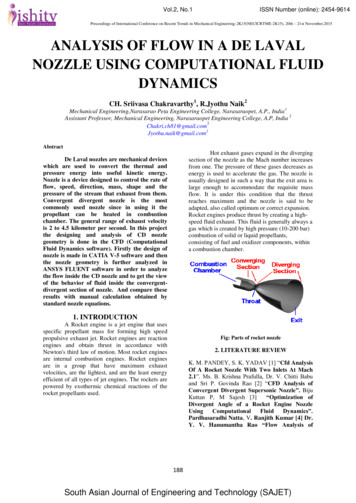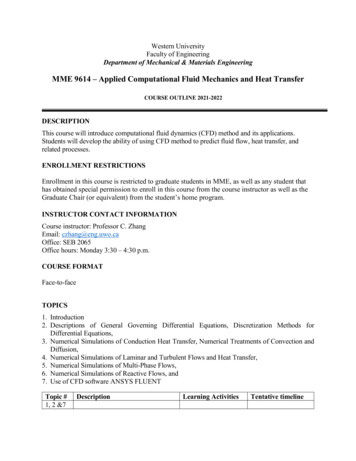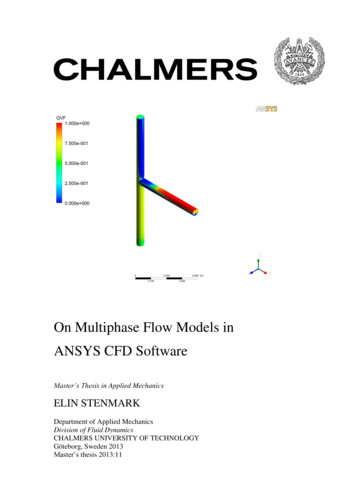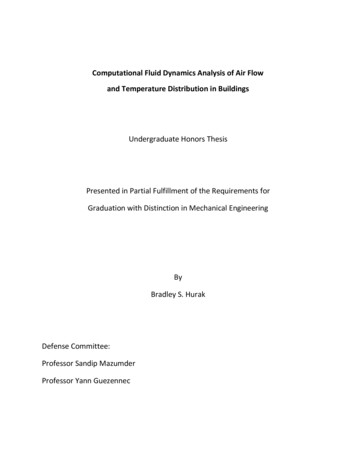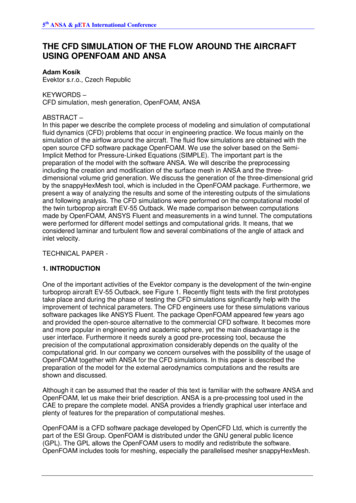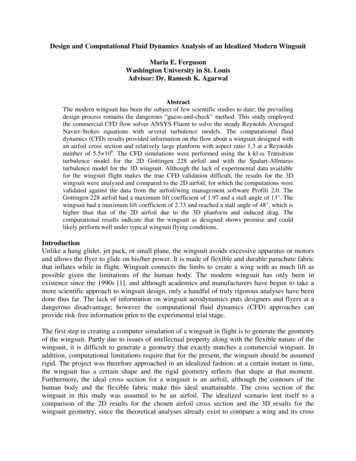
Transcription
Computational fluid dynamics (CFD) based approach to consequenceassessment of accidental release of hydrocarbon during storage andtransportationby Muhammad Masum JujulyA thesis submitted to the School of Graduate Studies in partial fulfillment of therequirements for the degree ofMasters of EngineeringFaculty of Engineering and Applied ScienceMemorial University of NewfoundlandMay, 2016St. John'sNewfoundland
AbstractThis thesis investigated the risk of accidental release of hydrocarbons duringtransportation and storage. Transportation of hydrocarbons from an offshore platform toprocessing units through subsea pipelines involves risk of release due to pipeline leakageresulting from corrosion, plastic deformation caused by seabed shakedown or damaged bycontact with drifting iceberg. The environmental impacts of hydrocarbon dispersion canbe severe. Overall safety and economic concerns of pipeline leakage at subseaenvironment are immense. A large leak can be detected by employing conventionaltechnology such as, radar, intelligent pigging or chemical tracer but in a remote locationlike subsea or arctic, a small chronic leak may be undetected for a period of time. In caseof storage, an accidental release of hydrocarbon from the storage tank could lead poolfire; further it could escalate to domino effects. This chain of accidents may lead toextremely severe consequences. Analyzing past accident scenarios it is observed thatmore than half of the industrial domino accidents involved fire as a primary event, andsome other factors for instance, wind speed and direction, fuel type and engulfment of thecompound. In this thesis, a computational fluid dynamics (CFD) approach is taken tomodel the subsea pipeline leak and the pool fire from a storage tank. A commercialsoftware package ANSYS FLUENT Workbench 15 is used to model the subsea pipelineleakage. The CFD simulation results of four different types of fluids showed that thestatic pressure and pressure gradient along the axial length of the pipeline have a sharpsignature variation near the leak orifice at steady state condition. Transient simulation isii
performed to obtain the acoustic signature of the pipe near leak orifice. The powerspectral density (PSD) of acoustic signal is strong near the leak orifice and it dissipates asthe distance and orientation from the leak orifice increase. The high-pressure fluid flowgenerates more noise than the low-pressure fluid flow. In order to model the pool firefrom the storage tank, ANSYS CFX Workbench 14 is used. The CFD results show that thewind speed has significant contribution on the behavior of pool fire and its domino effects. Theradiation contours are also obtained from CFD post processing, which can be applied for riskanalysis. The outcome of this study will be helpful for better understanding of the domino effectsof pool fire in complex geometrical settings of process industries. The attempt to reduce andprevent risks is discussed based on the results obtained from the numerical simulations ofthe numerical models.iii
AcknowledgementsFirst and foremost, I would like to express my profound gratitude to my supervisor, Dr.Faisal Khan, and co-supervisors Dr. Aziz Rahman and Dr. Salim Ahmed for theirsupport, motivation, encouragement, supervision and suggestions throughout the researchwork. Their extensive guidance motivated me to complete my research work successfully.Besides my advisor, I would like to thank Dr. Premkumar Thodi for his continuousencouragement, insightful comments. His knowledge and technical suggestions helpedme to develop the model successfully. I also acknowledge the support providedby INTECSEA Canada, MITACS at Memorial University of Newfoundland, PetroleumResearch Newfoundland & Labrador (PRNL), Vale Research Chair Grant, Research &Development Corporation (RDC) of Newfoundland & Labrador and Natural Sciences andEngineering Research Council (NSERC) of Canada.I would like to thank my fellow lab mates: Samith Rathnayaka, Junaid Hassan, AminulIslam Khan, Dan Chen, Omit Mehfuz and all other members of Safety and RiskEngineering Group (SREG) for their valuable ideas, discussions and help in every aspectduring this time. Finally, I would like to specially thank my parents, relatives and friendsfor their support and encouragement to pursue this degree.iv
Table of ContentsAbstract . iiAcknowledgements .ivList of Tables . viiiList of Figures .ixList of Symbols and Abbreviations . xiiIntroduction . 11.1 Overview of Storage and Transportation Risk . 11.1.1 Overview of Storage Facilities Risks . 41.1.2 Overview of the Pipeline Transportation Risks . 51.2 Motivation of the Research . 91.2.1 Research Motivation of Numerical Simulation of Pipeline Leakage . 101.2.2 Research Motivation of Numerical Simulation of Hydrocarbon Pool Fire . 101.3 Objectives of the Research . 111.4 Contributions . 131.5 Organization of the Thesis . 14Literature Review . 162.1 Preface . 162.2 Pipeline Leakage . 172.3 Pool Fire . 19v
2.4 Consequence Analysis of Fire, Explosion and Fluid Dispersion . 20Subsea Pipeline Leak Modeling using Computational Fluid Dynamics . 233.1. Introduction . 253.1.1 Background . 253.1.2 Literature review . 273.2. Theoretical Framework for CFD Simulation . 293.2.1 Sub-models . 313.3. Simulation Methodology . 403.3.1 Flow Inside the Pipeline Model . 403.3.2 Fluid Dispersion Model . 453.4. CFD Code Validation . 463.5. Results and Discussions . 473.5.1 Steady-State Simulations . 473.5.2 Transient Simulations . 633.6. Conclusions and Future Works . 76LNG Pool Fire Simulation for Domino Effect Analysis. 784.1 Introduction . 794.2 Theoretical Framework for CFD Simulation . 844.2.1 Sub-models in Fire Modeling . 874.3 CFD Simulation Procedure . 924.4 Result and Discussions . 974.4.1 Experimental Result from Literature . 97vi
4.4.2 CFD Result Validation . 994.4.3 Pool Fire Characteristics and Hazard Analysis . 1014.4.4 Domino Effect Accident Scenario . 1034.4.5 Discussion on the Influence of the Wind on Domino Effect Escalation . 1114.6 Conclusions . 115Summary, Conclusions and Recommendations . 1175.1 Summary . 1175.2 Conclusions . 1205.3 Future Works . 122Bibliography . 123vii
List of TablesTable 1-1Cause of failure of natural gas transmission pipelines in USA6Table 1-2Hazardous events for the storage of flammable materials7Table 3-1Acoustic sub-models comparison39Table 3-2Boundary conditions for the CFD simulation of flow inside44the pipeline and dispersion modelTable 3-3Receiver positions to monitor acoustic signals65Table 4-1Mesh-independency study by selecting different grid sizes94Table 4-2Initial conditions for the CFD simulation of pool fire95Table 4-3Boundary conditions for the CFD simulation of pool fire96Table 4-4Test result of LNG pool fire experiment in China Lake test98Table 4-5Experimental value from China Lake test and CFD result99viii
List of FiguresFigure 3-1Pipeline physical model and leakage position40Figure 3-2Isometric view of the pipeline model geometry43Figure 3-3Refined meshing of pipeline at the near wall and leak43Figure 3-4CFD code validation with literature46Figure 3-5Effect of pressure on fluids of leak orifice of 8 m pipe length48and 0.322 m diameterFigure 3-6Effect of high pressures on compressible fluid (methane)50Figure 3-7Vector profiles of pipeline with different fluids at pressure535300 psi and diameter 5mmFigure 3-8Zoomed view of local pressure change around the leak orifice55Figure 3-9Pressure variation of fluids along the axial length of the pipe,571mm below the leakFigure 3-10Pressure variation of fluids along the axial length of the pipe,575mm below the leakFigure 3-11Pressure gradient variation of different fluids along pipe lengthix58
Figure 3-12Zoomed view of pressure gradient contours of fluids along59with the pipe axial lengthFigure 3-13Turbulence kinetic energy (TKE) contours around the fluid60leakageFigure 3-14Turbulence eddy dissipation (TED) contours around the61leakageFigure 3-15Zoomed view of local temperature change around the leak63orificeFigure 3-16Receivers position at the pipeline65Figure 3-17Attenuation of acoustic pressure signal response near leak66orificeFigure 3-18Fast Fourier Transformation of the pressure signals at 670different leak positions. Water, 200 psi, velocity 9 m/sFigure 3-19Fast Fourier Transformation (FFT) of the pressure signals at 674different leak positions. Water, 5800 psi, velocity 9 m/sFigure 3-20Volume fraction of crude oil after dispersion at the subsea75Figure 3-21Zoomed view of the volume fraction of nitrogen and methane75after dispersion at the subseaFigure 4-1Solution procedure for a steady-state simulation by ANSYSCFX-14x85
Figure 4-2A schematic diagram of 3-D rectangular hexahedral mesh93applied in this simulation.Figure 4-3Mesh-independency study by selecting different grid sizes94Figure 4-4Illustration of LNG pool fire experiment in China Lake test98Figure 4-5CFD simulations of unconfined pool fire with temperature and103thermal radiation profiles of the flameFigure 4-6Layout of the LNG fuelled power plant104Figure 4-7Thermal radiation contour plot of the pool and maximum heat106flux received by the unitsFigure 4-8Maximum temperature distribution of flame and solid units108Figure 4-9Relation between the flame tilt angles (from vertical) and the111flame drag with wind speedFigure 4-10Maximum temperature and thermal radiation received by thenearest tank (T2) in different wind speedxi113
List of Symbols and AbbreviationsSymbolDefinitionDensity of fluid in kg/m3PStatic pressure in PaTTemperature in KTurbulent kinetic energy in j/kgPrandtl number forgGravitational acceleration in m/s2Velocity vector in m/sViscosity of fluid in m2/sEddy dissipation rate in m2/s3Prandtl number forVolume of fractionALeak orifice area in m2ΔPDifferential pressure in psiNCoefficient factorPressure gradient in Pa/mPSDPower spectral densityxii
FFTFast Fourier transformationLESLarge eddy simulationDODiscrete ordinatesMass fraction of speciesRTERadiative transfer equationStefan-Boltzmann constant (Soot mass fraction in kg/kgSpecific concentration of radical nuclei in mol/kgMass burning rate of fuel in kg/m2sRAMRandom-access memorySEPSurface emitting power in kW/m2L/DMean ration of pool fire length and diameteruwWind speed in m/sPRVPressure relieving valveCFDComputational fluid dynamicsLNGLiquefied natural gasRANSReynold’s Average Navier-StokesDESDirect numerical simulationxiii
Chapter 1Introduction1.1 Overview of Storage and Transportation RisksRisks of hydrocarbon storage and transportation are evaluated in this study. There arenumbers of incidents in hydrocarbon storage and transportation occurred includingLaSalle, Quebec (1965); Bucheon LPG filling station, Korea (1998); Ath, Belgium(2004); Buncefield, UK (2005); Puerto Rico, USA (2009); Sitapura, India (2009);Oakville, Ontario (2010); Nirobi pipeline fire, Kenya (2011); Sinopec Corp pipelineexplosion in China (2013) and most recently Tianjin, China (2015); where not onlyproperty losses were high, the death tolls were also enormous. In addition to asset andhuman loss, the reputation of the operating companies were plunged down. Conductingexperiments to simulate an industrial hydrocarbon fire scenario at this magnitude areextremely difficult and time consuming. Thus, to evaluate possible risks of nearby storageand transportation area a numerical approach is employed. The small scale fire andexplosions can be studied by experiments but the extrapolations of small scale fire andexplosion model to large industrial scale accident scenario is a challenge. Therefore, thenumerical approach is required to develop computational fluid dynamics modeling whichis capable to model both experimental and real case accidental fire scenario with complexcombustion process, and with complex geometry.1
A computational fluid dynamics software ANSYS platform is used to quantify the risksinvolved. It gives wide degree of freedom to the users regarding the three dimensionalhazard scenario for actual visualization. Moreover, numerical methods provide morespatial and temporal fidelity than analytical solutions. Analytical solution of amathematically defined problem is possible but the simplistic analytical models based onlimited boundary conditions and poor assumptions often lead to model error. Complexanalytical models are time consuming and highly non-linear equations are not evenpossible to solve with analytical techniques. For instance, there are two major types ofanalytical models of pool fire, the point source model and the solid flame model. Thepoint source thermal radiation models are based on the assumptions that the flame is asingle point source of thermal energy and the thermal radiation intensity varies inverselywith the square of the distance. The point source model can predict radiation in largerdistances from the flame but in closer distances it underestimates the thermal radiation. Inthe solid flame model a cylindrical shaped flame zone is considered as a radiating object.This model assumes similar irradiance of fire throughout the solid circle zone. Advancedturbulence model is not used in these models to capture the full dynamics of pool fire ineddy scale. During the wind scenario the tilt of the flame as a solid cylinder is practicallynot valid. In case of complex geometries these models cannot predict the exact behaviorof pool fire. Moreover, with analytical methods the domino effect cannot be fullycaptured. Although numerical methods are relatively complex, but they can reliablypredict radiation hazard [1].2
There are a number of risk scenarios involved in hydrocarbon storage and transportationoperation. Many of these can be anticipated but not all of these are accounted forcatastrophic disaster. The possible risk scenarios are [2]: Subsea pipelines and subsea blowouts will result in dispersion of hydrocarbonrelease in aquatic environment Leakage when loading the crude hydrocarbon to the processing unit Leakage from the storage tanks results pool fire or toxic release Leakage from the pipelines attached to the storage tanks results fire and explosion Traffic accidents within or outside of the perimeter leads fire and explosion Natural disasters (i.e. earthquake or lightening) could cause toxic release or fireand explosion Terrorism or vandalism causing toxic release or fire and explosionThere could be more unforeseen events which can lead to a major incident duringhydrocarbon handling. Only two major scenarios will be considered in this thesis, leakagefrom the subsea export pipelines and the leakage from the storage tanks. Consequences ofthese two scenarios will lead toxic dispersion at aquatic environment and the result of fireand explosions which are the most frequent accident scenarios [3, 4].3
1.1.1 Overview of Storage Facilities RisksThe largest quantities of hazardous material are found in storage facilities; consequencesof the storage accident are also severe. The hazard of toxic release and fire and explosionin storage may cost both financial losses and the loss of life. Smokes, heat radiation andtoxic fluid dispersion resulting from fire and explosion of storage and transportation linesare the largest threat for the whole operation of petroleum industries [1].The leakages at the storage tanks and the transportation pipelines are also very commonphenomena. The probabilities of fire and explosion risk are higher if there is a leakage inthe storage tanks or the transportation pipelines. The leakage from the loading, storagetanks or the adjunct pipelines can cause fire and explosions. Since the 1950’s more than450 tank fire incidents have been identified worldwide. Tank fires are estimated to bearound 15-20 every year [5].One of the main reasons of fire and explosions is the discharge of gasoline from theleakage of storage tank and from the adjacent pipelines of the tank. Pipelines are used totransport the hydrocarbons from the tanker to the reservoir or vessel for storage and fromthe tanks to the transportation trucks via the loading racks. There are thousands ofconnections, joints and valves between pipes and tanks. According to the designspecification, those connections have to be tight enough to avoid any leakages but that isnot the case all the time. Corrosion, metal fatigue due to external stresses, erosion inwelding joints are the problems that brought up since tanks and pipelines are made ofmetals [2]. A minor spark from the static electricity could ignite the hydrocarbons. There4
could be some other sources of ignitions for instance ignition due to explosion energy,external heat from the surroundings, or flash ignition from flammable vapour-couldmixtures [6].1.1.2 Overview of the Pipeline Transportation RisksPipeline is one of the major mode of transportation of hydrocarbons. Pipeline carryinghydrocarbons and other flammable materials can be exposed by jet fire or flammablevapour cloud, leading flash fire or vapour cloud explosion (VCE). Another major accidentscenario for pipeline transportation is the liquid spillage, which can lead to pool fire or thetoxic liquid dispersion. The older pipelines were made of mild steel or cast iron, however,the standards of construction and protection of pipelines have been improved to preventcatastrophic accidents. In order to minimize the external corrosion cathodic protection isutilized with combination of wrapping the pipeline by tar or glass fiber. Intelligentpigging is introduced to inspect the internal corrosion in order to prevent the pipelineleakage [1].5
Table 1-1: Cause of failure of inter-state natural gas transmission pipelines in USA1950-1965 [1].Hazardous eventsFrequency of occurrencePipelines punctured by plough, bulldozer, excavating279shovel, road grader or any other equipmentCorrosion:Corrosion at external pipe surface148Corrosion at internal pipe surface45Welding failure190Action of the elements84Coupling failures65Damage during installation58Fatigue failures35Defective pipe26Thermal stress21External l10586
Table 1-2: Hazardous events for the storage of toxic and flammable materials [1]Hazardous eventsMaterialsStateStorageHazardous eventsconditionFlammableLiquidAtmosphericLiquid release, tank fire, tank explosionLiquefiedPressureFlashing liquid release - flammable vapourgascloud, liquid pool, pool fire, jet fire, VCE,jet fire, BLEVELiquefiedRefrigeratedFlashing liquid release - flammable vapourgascloud, liquid pool, tank fire, VCE, fireengulfed tank, tank fire, bund pool fire,running fireToxicLiquidAtmosphericLiquid release, toxic gas could, tankexplosion, toxic gas cloudLiquefiedPressureFlashing liquid release - flammable vapourgasLiquefiedcloud, liquid pool, toxic gas cloudRefrigeratedFlashing liquid release - flammable vapourgascloud, liquid pool, toxic gas cloud, fireengulfed tank.7
Table 1-1 shows the cause of failure of natural gas transmission pipeline in the USA from1950-1965, during this fifteen years only there were 1058 failures causing 64 deaths and135 injuries. According to conservation of clean air and water in Europe (CONCAWE),during the period of 1972-76 there were 93 spillages by pipeline in Europe and the failurerate is 1.05x10-3 /km-year. The failure rate was 0.5x10-3 /km-year for the period 19871991. Table 1-2 shows the consequences of the failures described in Table 1-1.In case of subsea pipelines the main hazard is the leakage. The subsea condition maylikely be harsh as well as remote and inaccessible. Arctic marine pipelines can bedamaged by contact with drifting iceberg. Intense deformations could occur beneath agouge, and a trenched pipeline might still be damaged. Pipeline can also be plasticallydeformed by seabed shake down event as a consequence of ice gouging. It can lead tocatastrophic events and can have adverse effects on wildlife, environment, economy andthe reputation of the company since it is very difficult and expensive to clean up oil spillin harsh environment like arctic and subsea [3].8
1.2 Motivation of the ResearchPipeline failure during transportation and vessel failure during storage of hydrocarbons orflammable materials are the most frequent accidents. Thus, the risk of the leakage fromthe subsea export pipelines and pool fire due to vessel failure is immense. There arenumbers of studies conducted on safer process plant design in order to maintain safeworkplace and several safety codes are available in contemporary literatures. A numberof safety guidelines have been proposed to prevent accidents. Still storage tank andpipeline transportation are considered as a serious threat for the industries dealing withhydrocarbons and flammable materials; and this is the primary motivation to conductnumerical modeling of the subsea pipeline leak and the pool fire from the storage tank.According to Khan and Abbasi (1999), of the 3222 accidents from 1926-1997, 54% arefixed installation, 41% are transportation and 5% miscellaneous accidents. Further, 18%of the 1320 transportation accidents can be classified during pipeline transport which are228 cases. The same study also revealed that there are 1744 significant accidents occurredduring 1928-1997 due to the vessels or equipment failure. 25% of the 1744 accidentsinvolve fire and explosions and the rest involves toxic release or the combinations of fire,explosion and toxic release [7].9
1.2.1 Research Motivation of Numerical Simulation of Pipeline LeakageNumerical simulation of pipeline leakage in subsea condition is relatively new and verypromising research area. From research perspectives, it is difficult to conduct experimentson subsea pipelines. In some events, the pipeline fluid transfer has to shut down toconduct a proper experiment. Furthermore, because the industrial full-scale pipeline islarge in diameter, pipeline hydrodynamics cannot be captured accurately in a small-scale,lab environment. Thus, a numerical simulation can provide a better understanding ofpipeline flow and the consequences of pipeline leaks in different scales, reducing the costand number of experiments. ANSYS computational fluid dynamics software can be usedto serve this purpose. ANSYS workbench provides integrated modular design, meshingtechnology, and large degree of freedom for pre- and post-processing for the fluid flowsimulation in pipeline. Most importantly, ANSYS is highly interactive which will allowfor better visualization of the problem and its solution.1.2.2 Research Motivation of Numerical Simulation of Hydrocarbon Pool FireLike the subsea pipelines, it is also very challenging to conduct experiments involvingpool fire resulting from vessel failure; especially experiments to study domino effects.There are several analytical and semi-empirical methods to calculate the radiationintensity and overall risk evaluation, however, those methods have limitations in case ofcomplex three dimensional geometry. Under valid assumptions and boundary conditions,CFD models have much better temporal and spatial dependability than point source or10
solid flame models. The three dimensional simulation of complex geometrical structure ofa process plant can be performed by CFD. Apart from some constraints like simulationtime and valid boundary conditions, CFD is the most reliable and realistic method forcalculating risk from fire hazard [25].1.3 Objectives of the ResearchThere are two major objectives of this research. The first one is to perform numericalinvestigations of subsea pipeline leakage. The pressure noise data generated for the leakat the pipeline was processed through FFT (Fast Fourier Transform) and presented datafor different leak locations around the leak. The response of pressure and temperaturefrequency domain to input perturbations will be calculated from a steady state simulation.The local pressure and temperature contours will also be generated and these contourswill help to identify the position of the leak. Thus, the flow in a pipe and response to aleak will be studied. The influence of size of the leak on the test fluid pressure andtemperature distribution will also be investigated. Leaks create acoustic signatures due tothe high turbulence and high pressure around the vicinity. A transient simulation usinglarge eddy simulation (LES) will be used for simulating acoustic signature of the leakage.Another objective is to investigate the fate of the fluid after its release. CFD method isable to perform proper consequence modeling as a part of a risk assessment. Simplifiedmethod for dispersion prediction is generally not very useful, however, CFD tools havethe potential to model the relevant physics and predict the dispersion pattern well. Not11
many numerical studies are currently available on the dispersion of hydrocarbon from asmall leakage in subsea environment; this study can be a potential milestone. Leakagesfrom a pipe can result in damage to the ambient environment depending on the totalamount of released hydrocarbon and the concentrations in the proximity of the leakage,even there is a chance that hydrocarbons will dissipate or ignite and explode. The pipelineleakage consequence model would quantify the hydrocarbon volume released during thechronic small leakage. The vector plot and the velocity profile of the leaked fluid wouldaccurately provide the information on the fluid dispersion and its migration path. Plumetrajectory as well as mixing behavior with the initially stagnant atmosphere will beanalyzed and presented in the form of space–time concentration distribution and distancesto a given concentration. The leakage flow patterns along with the leakage diameters canalso be observed using th
compound. In this thesis, a computational fluid dynamics (CFD) approach is taken to model the subsea pipeline leak and the pool fire from a storage tank. A commercial software package ANSYS FLUENT Workbench 15 is used to model the subsea pipeline leakage. The CFD simulation results of four different types of fluids showed that the

